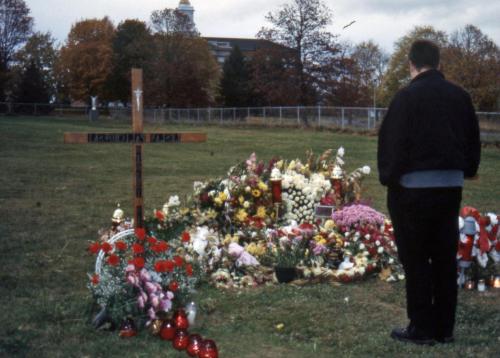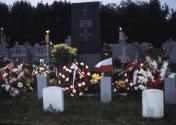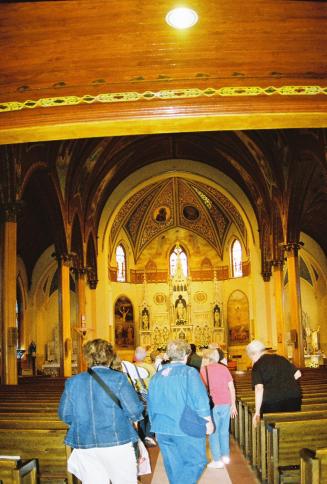All Souls Day, New Britain, 2000
Date2000 November
MediumPositive color film slides
ClassificationsGraphics
Credit LineConnecticut Cultural Heritage Arts Program collections
CopyrightIn Copyright
Object number2015.196.1046.1-.27
DescriptionSlide photographs of All Souls Day at Sacred Heart Cemetery in New Britain, Connecticut in November 2000. On this day, Polish families visited and decorated the graves of departed family members. This event was documented as part of CCHAP's fieldwork for the "Polonia w Connecticut" exhibit project.
(.1): An unidentified person standing near a grave.
(.2-.14): New Britain’s Sacred Heart Cemetery decorated with candles and flowers for All Souls Day.
(.15-.16): People in Sacred Heart Cemetery.
(.17-.27): New Britain’s Sacred Heart Cemetery decorated with candles and flowers for All Souls Day.
NotesSubject Note: The Polish community comprises nearly 10% of the state’s population, settling here during the late 19th and early 20th centuries when New England’s industrial growth made jobs plentiful in mills and factories. Thousands from rural areas of Poland left behind difficult political and economic circumstances to work in America. A similar movement of people took place in the 1980s, and Polish newcomers continue to arrive, bringing a very different sense of “Polishness” and cultural tastes from the older immigrants. Uprooted from their homeland and all that is familiar, these new Americans have found refuge in maintaining traditional customs, beliefs, foods, language, and joining together in fraternal, cultural, political, academic, and veterans societies. Parish churches fill a very important function as centers for social organization and cultural unity as well as providing spiritual and emotional comfort. The Polish saying Co kraj, to obyczaj explains that in the American Polish communities called Polonia some of the old practices change to fit new circumstances, or disappear altogether among recent generations. (.1): An unidentified person standing near a grave.
(.2-.14): New Britain’s Sacred Heart Cemetery decorated with candles and flowers for All Souls Day.
(.15-.16): People in Sacred Heart Cemetery.
(.17-.27): New Britain’s Sacred Heart Cemetery decorated with candles and flowers for All Souls Day.
The seasonal round of celebrations, festivals, holidays, along with the activities and art forms associated with them, connect Polish Americans to a dimension of beauty, meaning, spirituality, and heritage which they remember from the past but also practice today. In Connecticut works of art and everyday objects for use in the home are still made by hand in traditional Polish styles. Older objects from Poland are often redecorated with materials found here, and the process of creating and using these pieces shows an active expression of identity, not a mere recreation of old folk art forms.
New Britain, the center of Polonia in Connecticut, has a longstanding language school and folk dance group. Central Connecticut State University hosts the Polish and Polish American Studies Program and Library – one of only two such programs in the country. Broad Street is a thriving center of Polish commerce and activity, and has hosted an annual festival since 2012 called “Little Poland.” The festival is held in late April to mark Poland’s Constitution Day, a celebration of the democracy enjoyed by Americans under their country’s Constitution. In Hartford, the historically Polish neighborhood around Wyllys St/Popieluszko Court/Charter Oak Avenue included SS Cyril and Methodius Church, the Church School, the Polish National Home, and several businesses.
Community celebrations and seasonal holidays often follow the liturgical calendar of the Church. Christmas is celebrated with Pasterka, the midnight mass of the shepherds when koledy, holy carols, are sung. On the Feast of Epiphany, chalk is blessed in the church and used to inscribe door lintels with K + M + B, the initials of the three kings. At Easter, baskets of food for the Easter breakfast are blessed in the church. Processions mark Corpus Christi, the Feast of the Blessed Sacrament (and a ritual to ensure good crops) in June. In the late summer, harvest festivals called Dożynki featuring an open-air or church Mass with a blessing and distribution of bread, folk dancing, craft and food vendors are held in New Britain, Bristol, and Bridgeport/Ansonia. Harvest ornaments, large structures of wheat sheafs decorated with flowers and ribbons, are made and displayed by community artists. On All Souls Day in November Polish families visit the graves of their relatives, decorating them with candles and flowers after an outdoor mass.
Subject Note: "Polonia w Connecticut: Polish American Traditional Arts in Connecticut," an exhibition describing the arts and customs of this large community in Connecticut, was developed by CCHAP in collaboration with members of the Polish community, and was displayed in the gallery of the Institute for Community Research (ICR) from December 7, 2000 to May 2001. The project aimed to bring forward the enduring traditions of Polish American communities in Connecticut by conducting fieldwork in these communities, by collecting art works which express community traditions which still are practiced, by presenting an exhibition and related programming to the public and for schoolchildren, and by developing closer ties with the Polish community as ICR was situated in the heart of Hartford’s historic Polish neighborhood. Project partners included the Polish National Home, Ss. Cyril and Methodius Church and School, the Polish Cultural Club of Greater Hartford, the Polish Studies Department at Central Connecticut State University, and a number of community-based local Polish artists and collectors. Marek Czarnecki, an accomplished Byzantine iconographer and scholar from the Bristol Polish community, served as co-curator and gave a gallery talk on March 3, 2001. The project produced a catalogue of exhibit texts and information in both English and Polish. At the exhibit opening, performances were given by the Gwiazdeczki Dancers, a longstanding folk dance group from Saints Cyril and Methodius School and Parish, Hartford, and Wladyslaw Furtak, a singer, storyteller and woodcarver from the Gorale region of Poland who resides in Ansonia. Project funders included the Edward T. and Ann C. Roberts Foundation, the Connecticut Commission on the Arts, the National Endowment for the Arts, and the Polish Studies Dept. of CCSU.
The exhibit was timed to coincide with the annual "szopka contest" in late November when students from schools in New Britain and Hartford would create szopki - traditional Polish nativity scenes - then bring them to Hartford's Polish National Home on Charter Oak Avenue where a panel of judges awards prizes for excellence and creativity during the annual szopka festival. Some of these szopki were included in the CCHAP exhibit. Traditional art forms such as papercutting (wycinanki), painted eggs (pisanki), icons, embroidery, harvest ornaments, Christmas ornaments, and folk costumes all made by Connecticut Poles were featured, and the exhibit also included handmade altars and figures made for devotional use in people's homes, a common Polish practice. The exhibit demonstrated the beauty, usefulness, and continuation of traditional arts specific to the large Polish-American community in Connecticut, while also noting the ways traditions become altered in a new world setting.
Additional materials exist in the CCHAP archive for this community.
Cataloging Note: This project was made possible in part by the Institute of Museum and Library Services MA-245929-OMS-20.
Status
Not on view2008 April 19
2022 July 8
2000 May 11




































